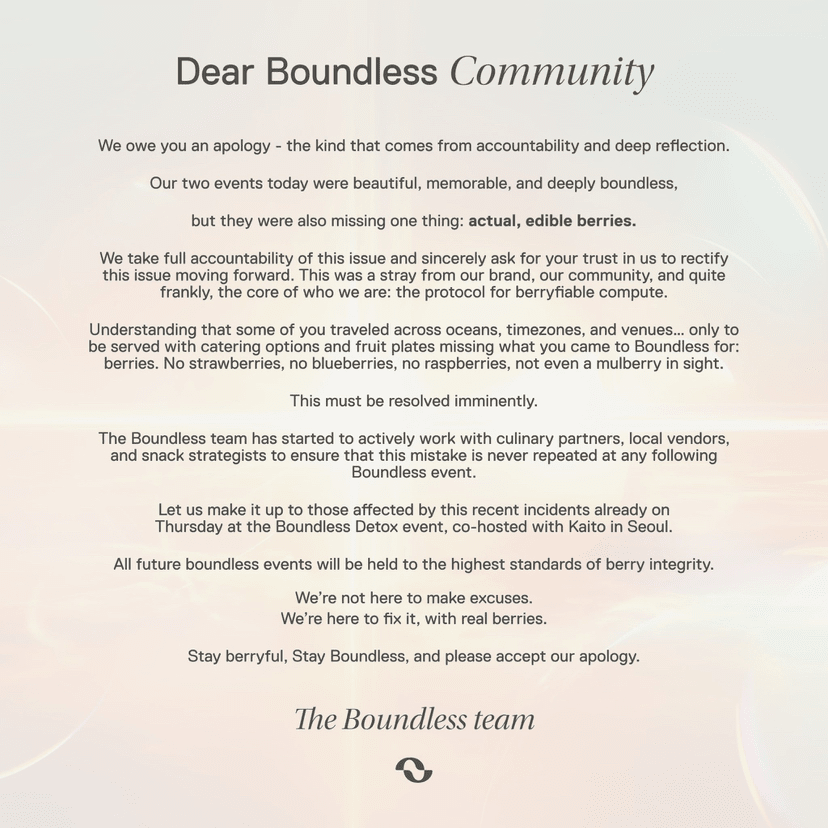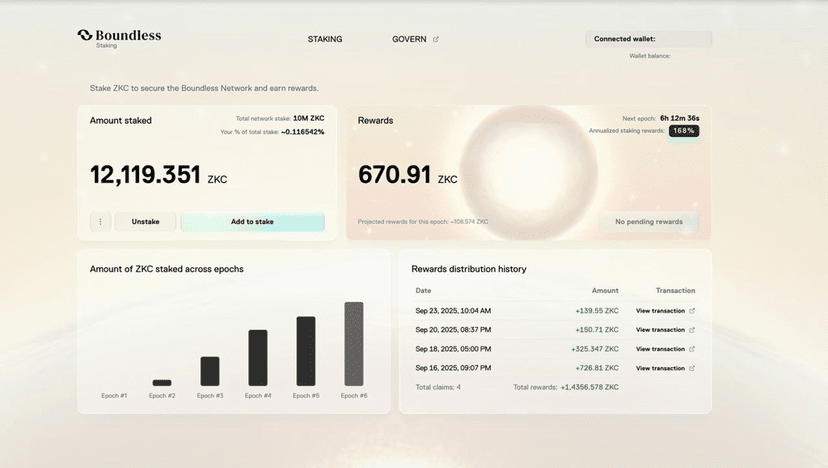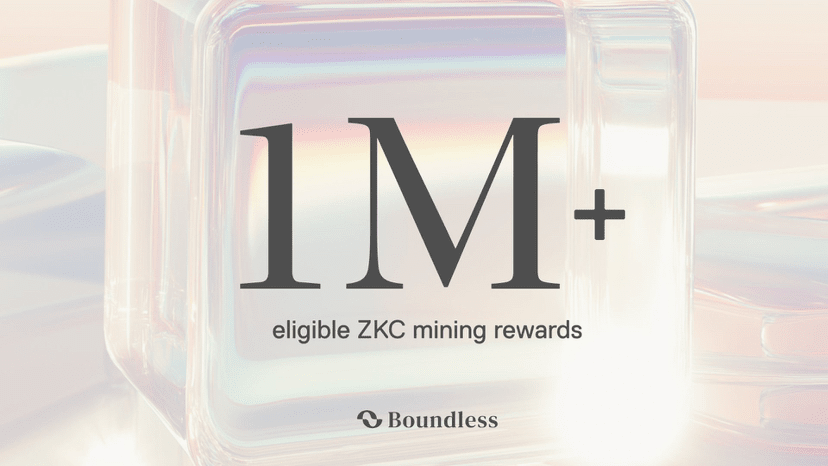 Introduction: Navigating through the fog to find a new order in the crypto world
Introduction: Navigating through the fog to find a new order in the crypto world
In the vast universe of cryptocurrencies, countless projects shine like stars. However, there are few projects that can truly navigate market cycles and continuously create value. The Boundless project, with its groundbreaking technological architecture, unique governance model, and revolutionary economic design, is quietly changing this landscape, and its native token ZKC is the key link connecting this ecosystem.
This article will delve into the core concepts, technological innovations, ecological layout, and economic model of the ZKC token of the Boundless project, exploring its positioning in the current cryptocurrency world and its future development potential.
1. The Philosophical Foundation of the Boundless Project: Boundless but not disorderly
The name of the Boundless project itself embodies deep meaning—"boundaryless" does not imply a lack of rules and order, but represents breaking the limitations of traditional blockchain projects in scalability, privacy protection, and interoperability. The project’s founding team is deeply influenced by the cyberpunk movement and the concept of decentralized autonomous organizations (DAOs), committed to creating a truly decentralized, self-governing blockchain ecosystem with unlimited scalability.
Unlike traditional blockchain projects, Boundless is not limited to a single technological route or application scenario, but has built a multi-layered, cross-chain interoperable protocol cluster, allowing different tech stacks and application scenarios to coexist, interconnect, and create value within its framework. This "boundaryless" concept reflects the project’s deep insight into the future development direction of blockchain— the future belongs to ecosystems that can break the island effect and achieve true value intercommunication.
2. Technological Innovation: A perfect combination of zero-knowledge proof and modular architecture
The technological foundation of the Boundless project is built on two core innovations: zero-knowledge proof technology and modular blockchain architecture.
1. Zero-Knowledge Proof: Balancing privacy and efficiency
The "ZK" in the name of the ZKC token stands for "Zero Knowledge," implying the project's deep application of zero-knowledge proof technology. Boundless employs an innovative zkSNARK and zkSTARK hybrid verification mechanism that not only ensures transaction privacy but also significantly improves network throughput and verification efficiency.
It is particularly worth mentioning that the "ZK-Rollups+" technology developed by the Boundless team has improved the transaction processing speed of traditional ZK-Rollups by nearly 300% through optimizing the computation proof generation process, while reducing users' gas fees by over 60%. This breakthrough makes Boundless one of the most cost-effective privacy trading solutions on the market today.
2. Modular Blockchain Architecture: The ultimate expression of flexibility and scalability
The Boundless project adopts cutting-edge modular blockchain design concepts, separating data availability, consensus mechanisms, execution environments, and settlement layers, allowing each module to be independently optimized and replaced or upgraded according to needs. This modular design brings unprecedented flexibility and scalability.
Specifically, the architecture of Boundless includes:
Data Layer: Utilizes distributed storage technology to ensure the persistent availability of data
Consensus Layer: Implements an innovative "adaptive consensus protocol" that automatically adjusts the consensus mechanism based on network load
Computation Layer: Supports Turing-complete smart contracts and introduces the concept of a "computation market" to optimize resource allocation
Settlement Layer: Responsible for the final confirmation and secure transfer of cross-chain assets
This architectural design allows Boundless to flexibly adjust according to the needs of different application scenarios while maintaining the overall security and consistency of the system, providing unlimited possibilities for future expansion.
3. ZKC Token: Not just a value carrier, but the core of ecological governance
1. Token Economic Model: Deflationary design and value capture
The ZKC token adopts a carefully designed deflationary model, with a total supply of 100 million tokens, distributed as follows:
Ecosystem Development and Incentives: 35%
Team and Advisors: 20% (4-year linear release, 6-month lock-up period)
Initial Investors: 15% (2-year linear release)
Community Governance Fund: 15%
Liquidity Mining and Staking Rewards: 10%
Strategic Reserve: 5%
The value capture mechanism design of the ZKC token is exquisite, with each transaction in the network generating a certain proportion of fees used for repurchasing and destroying ZKC. As network usage increases, the token supply will gradually decrease, forming a positive deflationary effect.
2. Multi-dimensional Utility: Token design that transcends a single function
Unlike many cryptocurrencies that are merely speculative tools, ZKC performs multiple key functions within the Boundless ecosystem:
Governance Rights: Holding ZKC allows participation in key decision-making votes within the ecosystem
Staking Rewards: Staking ZKC can earn a share of network transaction fees
Service Payments: Used as a medium for payments for various services within Boundless
Liquidity Mining: Providing liquidity to the ecosystem can earn additional ZKC rewards
Identity Verification: Holding a certain amount of ZKC unlocks specific advanced features
This multi-dimensional utility design ensures the core position of ZKC tokens in the ecosystem while providing holders with diversified value return paths.
4. Ecological Layout: Building a boundaryless network of value flow
The ecological layout of the Boundless project far exceeds a single application or protocol, but rather builds a complete blockchain infrastructure and application ecosystem.
1. Core Infrastructure
Boundless Bridge: Cross-chain bridging protocol, supporting seamless asset transfer with mainstream public chains
ZK-Identity: A zero-knowledge proof-based identification system that ensures a balance of privacy and verifiability
Boundless SDK: Developer toolkit that lowers the development threshold for ecological projects
Oracle Network: Decentralized oracle network that provides reliable external data for smart contracts
2. Application Ecology
In the Boundless ecosystem, multiple innovative applications have already emerged:
BoundlessDEX: A decentralized exchange supported by zero-knowledge proofs, ensuring transaction privacy and efficiency
ZK-Loans: Unsecured credit loan protocol based on zero-knowledge proof credit assessment
MetaBound: Metaverse asset trading and management platform
DataMarket: Decentralized data trading market, protecting the privacy and rights of data providers
These applications not only enrich the functionality of the Boundless ecosystem but also increase the usage scenarios and demand for ZKC tokens through various mechanisms, forming a positive cycle.
5. Governance Innovation: Integration of Liquid Democracy and Representative Systems
The Boundless project has also boldly innovated in governance mechanisms, adopting a governance model that combines "liquid democracy and representative systems."
In this model, ZKC holders can choose to directly participate in governance votes or delegate their voting rights to professional "blockchain governance representatives." Representatives must pass strict qualification reviews and regularly disclose their voting philosophies and historical decisions. At the same time, the powers of any representative can be recalled by the delegators at any time, ensuring representatives are accountable to the delegators.
This governance design retains the transparency and participation of direct democracy while drawing on the professionalism and efficiency of representative systems, attracting widespread attention and discussion in the crypto community. Currently, there are over 200 active governance representatives playing important roles in the Boundless ecosystem.
6. Development Roadmap and Future Outlook
The development roadmap of the Boundless project is clear and ambitious, divided into four main phases:
Genesis Phase (2024-2025): Complete core technology development, establish initial ecosystem and governance framework
Expansion Phase (2025-2026): Expand cross-chain interoperability, increase application scenarios, and expand user base
Integration Phase (2026-2027): Integrate with traditional financial systems and develop enterprise-level solutions
Transcendence Phase (after 2027): Achieve a fully autonomous ecosystem and become a key component of blockchain infrastructure
Currently, the Boundless project is in the early stages of the Expansion phase, having achieved a series of important progress: establishing cross-chain protocols with three well-known public chains, attracting over 100 developer teams to build applications on the platform, daily active user count exceeding 50,000, and ZKC token market value entering the top 100 of cryptocurrency rankings.
7. Risks and Challenges: Rationally view the future of Boundless
Although the Boundless project shows great potential, we must also be soberly aware of the risks and challenges it faces:
Technical Risks: Zero-knowledge proof technology is still in development, and there may be undiscovered security vulnerabilities
Regulatory Risks: The global cryptocurrency regulatory environment is becoming increasingly stringent, which may affect project development
Competitive Risks: The privacy computing and cross-chain interoperability fields are highly competitive, and technological advantages may be quickly surpassed
Adoption Challenges: Large-scale applications of blockchain still face user experience and education barriers
Balancing Decentralization and Efficiency: Maintaining sufficient decentralization while pursuing high performance is a long-term challenge
In the face of these challenges, the Boundless team has adopted proactive risk management strategies, including regular security audits, the introduction of compliance advisors, ongoing investment in technological research and development, and community education programs.
Conclusion: Boundaryless, but not disorderly future
The Boundless project and its ZKC token represent an important direction in the development of blockchain technology—breaking islands, establishing interconnected value networks, while protecting user privacy and data sovereignty.
In this era of digital transformation, Boundless's "boundaryless" concept precisely captures the core of future development—true value lies not in building closed walled gardens, but in creating open, interconnected, yet orderly digital economic infrastructures.
For investors and participants, understanding Boundless is not just about understanding a cryptocurrency project, but also about understanding the future development direction of blockchain technology. Regardless of the market performance of ZKC tokens, the technological innovations and governance practices that the Boundless project showcases will become an important chapter in the history of blockchain development.
In a boundaryless digital world, order and freedom are not opposites, but mutually accomplished. The Boundless project is a vivid embodiment of this concept.

